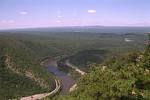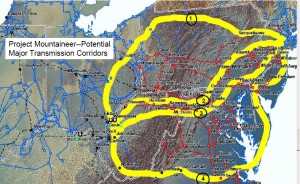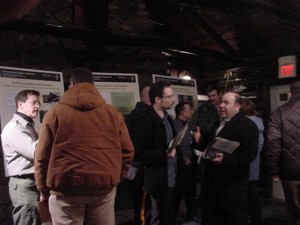Park Service releases EIS Scoping Report
April 29th, 2010
Imagine 190 foot transmission towers through the Delaware Water Gap, between Pennsylvania and New Jersey.
That’s what’s proposed by PSE&G for its Susquehanna-Roseland transmission line. This quad/tri bundled 500kV line is HUGE, ugly beyond belief, and it’s just so big that I can hardly comprehend, there’s nothing that large that I’ve found. Others like it are being cancelled by PJM due to lack of demand, and this one should be too…
From the Pocono Record:
Anyway, the National Park Service is doing an Environmental Impact Statement, and leading up to that is “scoping,” which, as Grant Stevenson noted yesterday at the Task Force meeting, is THE most misunderstood term. I agree. It just zooms over people’s heads, and comments end up being of the “I hate this project because___” and nothing that relates to what the scope of the environmental review should be. Utter waste of time, and something to be mindful of with the CapX 2020 transmission scoping meetings coming up.
SCOPE: Range, area of coverage, breadth
So “scoping” in this sense is the range, area of coverage, and breadth of environmental review.
We had comments on the scope a few months ago, and there were something like 6,500 comments. Yes, that’s right, SIX THOUSAND FIVE HUNDRED! At the meetings I went to, it was standing room only and the comments were notably on point, they were profound examples of those rare uplifting meetings. Facilitation of the meetings was so good it felt like they really were interested in what we had to say. It was all taken down by a court reporter. THAT level of attention and appreciation is SO rare… and dig this … afterwards I RECEIVED A THANK YOU NOTE FOR PARTICIPATING. That is a first, I’ve never gotten a thank you note from an agency for showing up and speaking out. I’m thinking of framing it (after sending it to MN’s Dept. of Commerce).
NATIONAL PARK SERVICE – SUSQUEHANNA-ROSELAND 500kV TRANSMISSION LINE PAGE
Here’s their report:
The next step?
We’ll keep you posted.
BPU issues Susquehanna-Roseland Order
April 21st, 2010
It’s out, hot off the press:
I feel a Motion for Reconsideration coming on…
National Park Service extends Comment period
March 5th, 2010
National Park Service has extended the deadline for EIS Scoping Comments on the Susquehanna-Roseland transmission project. WHEW! Now we have until March 12 to send our comments in!
Get your clues on Comments from what they do and do not include:
It’s in the Pocono Times:
From the NPS blog:
Posted March 5th, 2010 by Kurt Repanshek
High public interest has prompted the superintendents of Delaware Water Gap National Recreation Area, the Appalachian National Scenic Trail, and the Middle Delaware National Scenic and Recreational River and National Recreation Water Trail to extend by a week the public comment period on a proposal to run a transmission line across the areas.
The comment period was scheduled to end today, but has been extended through March 12.
There are numerous ways for the public to provide comments on the public scoping phase of the planning process, including leaving a message on the Park Planning Information Telephone Line (570-426-2491), submitting comments online through a link on the National Park Service Planning, Environment and Public Comment site, http://parkplanning.nps.gov (select Appalachian NST or Delaware Water Gap NRA), or by mailing comments to:
Detailed information about the need for the EIS and the project timeline
can be found on the National Park Service Planning, Environment and Public
Comment site: http://parkplanning.nps.gov.
FERC cost-apportionment docket heats up
February 24th, 2010
The cost apportionment remand at FERC is heating up. It’s that case where the 7th Circuit threw out the PJM cost apportionment scheme:
It went back to FERC and so FERC issued an Order requiring PJM to produce things that… well… things that will demonstrate that there’s no need for this project, things that will demonstrate the benefactor of these transmission lines, things that PJM doesn’t really want the world to know, like how they’ve incorporated O-P-T-I-M-I-Z-A-T-I-O-N, things going directly to N-E-E-D!
Seeing that, well, Stop the Lines had to join in, as did the Municipal Intervenors:
PJM begged for more time, an extension of 45 days!
And for some bizarre reason, FERC gave it to them:
Meanwhile, Exelon wants to bring in the kitchen sink, including 345kV transmission:
And parties they are a freakin’ and filing:
And then the weirdest of all – the American Wind Energy Ass (AWEA) wants to intervene, citing “the current significance of this issue in the context of efforts to build transmission to bring location-constrained, renewable resources to load…” Ummmm… SAY WHAT??
OK, I give up… in what parallel or alternate universe is the PATH or Susquehanna-Roseland line for wind? WHERE DO THEY GET THESE IDEAS? I want to see the basis for that statement. PRODUCE!
Earth to AWEA — can you spell P-R-O-J-E-C-T M-O-U-N-T-A-I-N-E-E-R?
If you need a hint, go to FERC eLibrary and search for A05-03. Happy reading!
NPS scoping hearings in progress
February 18th, 2010
Scene from yesterday’s NPS meeting at Camp Jefferson, Lake Hopatcong, NJ
PSEG’s Susquehanna-Roseland transmission line through the Delaware Water Gap is under scrutiny.
Just out – PSEG year end info (just searched SEC and don’t see it there yet):
And for some reason, I get that old hook line, a little perverted, i.e., “We gotta lock down our electric revenue, and then we’ll take it higher!”:
Yesterday was the second of three public comment hearings that the National Park Service is holding regarding PSEG’s application to expand the Right of Way and run its Susquehanna-Roseland through the Delaware Water Gap, a premier federally designated “wild and scenic” area. The good news is that people are really turning out, the first meeting, in Bushkill, PA, was about 100, and this meeting was twice that, standing room only in the log hall of Camp Jefferson.
Here is the NPS’ take on framework and issues for the Environmental Impact Statement:
Here’s a few snippets that I really find interesting — and of course want to expand on:
Air Quality
Construction and maintenance activities would impact air quality.Viewsheds
The new transmission lines and associated roadways would affect the visual viewshed. Viewshed impacts would be permanent. A separate viewshed analysis should be done for scenic and visual impacts. A comprehensive list of the viewsheds at DEWA does not exist at this time. However, the APPA is considered a scenic viewshed. The baseline conditions are represented by the current viewshed, which has not yet been evaluated.Climate Change/Greenhouse Gases
How the project contributes to the production of greenhouse gases and climate change, as well as how climate change would impact the project and park resources must be addressed in the EIS.Viewshed Appreciation
The new transmission lines and associated roadways could adversely affect the visitors’ appreciation of the visual viewshed. These impacts would be permanent. A separate viewshed analysis should be done for scenic and visual impacts for visitor experience.
The one that jumps out to me is “air quality.” I note that under “Climate Change/Greenhouse Gases” they acknowledge the project contribution of greenhouse gas and climate change, and that also needs to be added to the Air Quality section, the project contribution of pollutants to air quality.
Why? Check the RTEP, PJM’s 2007 RTEP that this Susquehanna-Roseland project was based on:
Critical RTEP Issues and Upgrades
PJM continues to address a number of issues with
a bearing on reliability in Pennsylvania and the
regional transmission expansion plans required to
maintain it:• Increasing power transfers through Pennsylvania to feed eastern Mid-Atlantic PJM load centers including those in Pennsylvania are expected to cause overloads beginning in 2016 on key circuits in Pennsylvania. New high voltage backbone facilities are required to mitigate these reliability issues. The new backbone facilities will also be assessed for their ability to support deliveries from a cluster of new coal-fired generating facilities currently proposed for central and northeastern Pennsylvania. Three major new backbone transmission facilities have been approved by the PJM to resolve growing reliability criteria violations in eastern Mid-Atlantic PJM and west/central Pennsylvania, upgrades that are now part of PJM’s RTEP:
• Susquehanna – Lackawanna – Jefferson – Roseland 500 kV circuit
• Amos – Bedington – Kemptown (PATH) 765 & 500 kV circuit
• Mid-Atlantic Power Pathway (MAPP): Possum Point – Calvert Cliffs – Indian River – Salem 500 kV Circuit
2007 RTEP, p.259-260 (emphasis added)
Beginning on p. 262, the RTEP lists 2,712 (check my math) of coal in queue. Yup, Susquehanna-Roseland could handle that! Here’s the full PA chapter of the 2007 RTEP — see for yourself:
The New Jersey one says essentially the same thing:
Those new coal plants and the impacts of facilitating/enabling those new coal plants and the impact on the Class I park must be addressed. The operational impacts, contributions to greenhouse gases, applies equally to air quality. This was an issue with Voyageurs National Park in the Mesaba Project review, and it should be here.
Here’s the “study area” designated by National Park Service – the “no data” spot is Picatinny Arsenal. What happens if you build transmission over an arsenal? What is the impact on the park if Picatinny Arsenal goes BOOM!?!?!
Here are some articles, thanks to Scott Olson ( Fired up and ready to go one more time! ) for compilation:
- Last stand: Critics slam power line plans across Delaware Water Gap, Appalachian Trail (Daily Record)
- Crowd of 200 puts Park Service on notice (New Jersey Herald)
- N.J. residents, environmentalists urge National Park Service to reject proposed $750M power line (Star-Ledger)
- New Jersey residents make plea to National Park Service to oppose power lines project (The Express-Times)





